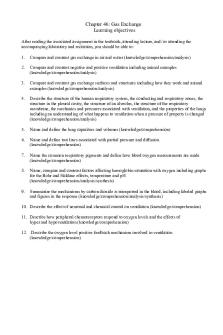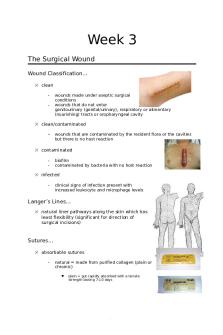345 Wk 5 Gas Exchange RSV Care Plan PDF

| Title | 345 Wk 5 Gas Exchange RSV Care Plan |
|---|---|
| Author | Summer Smith |
| Course | Concepts of nursing in chronic care ll and end of life |
| Institution | Nightingale College |
| Pages | 3 |
| File Size | 129.5 KB |
| File Type | |
| Total Downloads | 42 |
| Total Views | 143 |
Summary
Gas Exchange Postwork...
Description
345 Gas Exchange CB Care Plan on RSV Nursing Diagnosis (3-part statement)
1st Diagnosis: Pt is at risk for aspiration as evidenced by labored breathing, expiratory wheezing, coughing, and excessive mucus secretions.
2nd Diagnosis: Pt exhibits ineffective airway clearance as evidenced by her respiratory distress
Goals (1 per diagnosis and SMART)
Interventions (include 5 for each goal)
1) Pt to maintain an open airway as evidenced by normal breath sounds, decrease in excess mucus, and absence of cough by discharge.
1) Have suction available to use as needed to clear excess secretions. 2) Assess respiratory status, auscultate breath sounds for wheezing and crackles. 3) Assess cough and gag reflexes (presence or absence). 4) Assess pt for N/V. 5) Evaluate pt’s ability to swallow by assessing cough, “wet” gurgling sound in voice/cry, choking.
1) To have pt exhibit a reduced rate of respiration and for the guardians to verbalize their understanding of how to clear excess mucus from the pt’s airway by end of shift.
Rationale (1 reason for each intervention)
1) Suction may be necessary to maintain an open airway. Excess mucus can cause risk for aspiration and lead to other complications such as pneumonia. 2) Aspiration can occur without coughing or occur with sudden respiratory distress. 3) Cough and gag reflexes normally protect lungs from aspiration. Absence of cough or gag reflex increases pt’s risk for aspiration. 4) Nausea and vomiting can put a pt at higher risk for aspiration. Antiemetics may be used to help prevent aspiration. 5) With impaired swallowing reflexes, puts pt at risk for aspiration. 1) Monitor respiratory 1) Abnormalities can patters including rate, show respiratory depth, and effort compromise and increase 2) Instruct guardians on respiratory rate which can proper use of saline solution be a response to and bulb syringe and have obstruction of the airway. them demonstrate proper 2) Instructing guardians use of technique on pt on proper use of saline
Evaluation (Met, partially met, not met and explain progress) 1) Goal has been met as evidenced by normal breath sounds, decrease in excess mucus, and absence of cough by discharge.
1) Goal has been met as evidenced by guardians demonstrate proper saline solution and bulb syringe technique to pt. During reevaluation, pt’s RR was successfully lowered, excess mucus was removed, and O2 sat increased by end of shift.
345 Gas Exchange CB Care Plan on RSV and bulb syringe can help remove excess mucus to make it easier for pt to breath. 3) Monitoring O2 is important to ensure levels are >90% for adequate gas exchange. 4) Pt position is important to maximize pt airway to ensure they are getting enough O2. 5) Abnormalities may indicate an infection or other condition. Signs of infection include discolored sputum (other than clear or white) and odor. If secretions are thick, this may cause airway resistance and pt may have to work hard to breathe causing fatigue and thick secretions can also be a sign of dehydration. 1) Assess defining 1) Responses to stress characteristics of ineffective may vary and show the coping. level of coping skills. 2) Determine perception of 2) Some may feel that stressful situations. stress levels are greater 3) Assess what coping skills than resources available have helped in the past to help cope. By including problem solving understanding and and decision making. knowing what helps them 4) Assess level of cope, it helps to provide understanding material and the appropriate material to
3) Monitor pulse ox saturation levels as available 4) Position pt to optimize respiration 5) Assess secretions such as color, odor, amount, and viscosity
3rd Diagnosis: (psychosocial) Pt’s guardians at risk for ineffective coping as evidenced by concern of pt health status and lacking confidence in caring for pt.
1) Pt’s guardians use available resources and support system as well as describe effective coping strategies and positive results from new behavior by end of shift.
1) Goal met by pt’s guardians used available resources and support system as well as describing effective coping strategies and positive results of new behavior by end of shift.
345 Gas Exchange CB Care Plan on RSV their readiness to learn. 5) Evaluate support system available.
help them cope. 3) Knowing previous coping skills that have helped in the past can ensure they will learn to successfully cope with current situation. 4) Readiness to learn and understanding of material will help with learning how to successfully cope with stressful situations. 5) Having the proper support system will help them through stressful situations and help with the coping process.
Reference Gulanick, M., & Myers, J. L. (2014). Nursing care plans: Diagnoses, interventions, and outcomes. Philadelphia, PA: Elsevier/Mosby....
Similar Free PDFs

Gas Exchange
- 11 Pages

Gas Exchange concept notebook
- 4 Pages

Impaired gas exchange- Biology
- 7 Pages

Gas exchange and adaptations
- 8 Pages

Chap 46 Gas Exchange-SM17
- 17 Pages

Lecture 8 Gas Diffusion Exchange
- 23 Pages

UTI Care Plan - Care Plan
- 7 Pages

Care plan 3 - Care Plan
- 3 Pages

Care Plan 1 - Care plan
- 7 Pages

Care Plan 2 - Care plan
- 21 Pages

Wound Care Notes Wk 3
- 14 Pages

N101L Care Plan - Nursing Care Plan
- 11 Pages
Popular Institutions
- Tinajero National High School - Annex
- Politeknik Caltex Riau
- Yokohama City University
- SGT University
- University of Al-Qadisiyah
- Divine Word College of Vigan
- Techniek College Rotterdam
- Universidade de Santiago
- Universiti Teknologi MARA Cawangan Johor Kampus Pasir Gudang
- Poltekkes Kemenkes Yogyakarta
- Baguio City National High School
- Colegio san marcos
- preparatoria uno
- Centro de Bachillerato Tecnológico Industrial y de Servicios No. 107
- Dalian Maritime University
- Quang Trung Secondary School
- Colegio Tecnológico en Informática
- Corporación Regional de Educación Superior
- Grupo CEDVA
- Dar Al Uloom University
- Centro de Estudios Preuniversitarios de la Universidad Nacional de Ingeniería
- 上智大学
- Aakash International School, Nuna Majara
- San Felipe Neri Catholic School
- Kang Chiao International School - New Taipei City
- Misamis Occidental National High School
- Institución Educativa Escuela Normal Juan Ladrilleros
- Kolehiyo ng Pantukan
- Batanes State College
- Instituto Continental
- Sekolah Menengah Kejuruan Kesehatan Kaltara (Tarakan)
- Colegio de La Inmaculada Concepcion - Cebu



